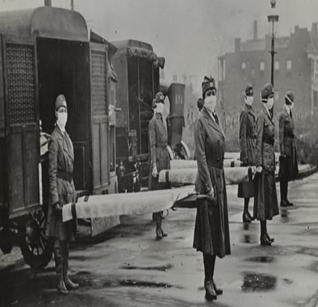Exactly 100 Years Ago, just as the First World War (WW1) were finally starting to wind down, the deadliest strain of influenza in modern history infected an estimated 500 million people worldwide and killed more than 50 million victims, including an untold number of Africans and some 675,000 Americans. At the time, there were no effective drugs or vaccines to treat this killer flu strain dub “The Spanish Flu” because Spain was the only country during the war to openly report the virus. It was a neutral country and was not involved in the WW1.
For those countries affected, social distancing and quarantine were used to curtail the spread of the pandemics. People were ordered to wear masks, churches, theaters and businesses were shuttered and bodies piled up in makeshift morgues. Some advised their citizens to also avoid shaking hands and to stay indoors, libraries put a halt on lending books and regulations were passed banning spitting. As can be seen below, every available town halls or space were transformed into hospitals and women were conscripted to serve as nurse transporting dead bodies for mass burials.
(1919 pandemic). Women transporting corpses Patients in make-shift hospitals overwhelmed with victims.
Additionally, hospitals in some areas were so overloaded with flu patients that schools, private homes and other buildings had to be converted into makeshift hospitals, some of which were staffed by medical students as there was a shortage of doctors and other health workers caused by the war. In some places there weren’t enough farm workers to harvest crops. Basic services such as mail delivery and garbage collection were hindered due to flu-stricken workers. By the summer of 1919, the flu pandemic came to an end, as those that were infected either died or developed immunity. Some estimates put the number of deaths as more than 50 million making it the worse pandemic in the history of mankind.
Those protective measures adopted to fight the epidemic 100 years ago, are similar to the harsh restrictive measures employed by many countries including the Gambia to curb the spread of covid-19 as recommended by the WHO. In the realm of infectious diseases, in terms of mortality rates, the 1918-19 epidemic clearly reveals how much more severe the 18th century influenza was relative to coronavirus pandemic and other deadly viruses that emerged during the last century.
So far, a total of 199 countries and territories have been affected with the coronavirus going by the latest provisional data made available as at 17.28 03/30/20 as follows:
Coronavirus Cases- Tuesday, 30th March 2020
| Country | Total Cases | New Cases | Total Deaths | New Deaths | Total Recovered | Active Cases |
| World | 760,392 | +37,002 | 36,864 | +2,799 | 160,148 | 563,380 |
| USA | 152,631 | +9,140 | 2,817 | +234 | 5,211 | 144,603 |
| Italy | 101,739 | +4,050 | 11,591 | +812 | 14,620 | 75,528 |
| Spain | 85,195 | +5,085 | 7,340 | +537 | 16,780 | 61,075 |
| China | 81,470 | +31 | 3,304 | +4 | 75,700 | 2,466 |
| Germany | 63,929 | +1,494 | 560 | +19 | 9,211 | 54,158 |
Source: Worldometer.info
Gambia is one of the lowest countries with the lowest number of reported cases of 4 with and one death so far. Both United States, Italy and Spain have overtaken China in terms of number of cases. However, both Italy and Spain have reported more deaths than China and USA combined. Many theories have been forwarded for the reasons for this inexplicable circumstances but one thing is certain, taking the right protective measures on time before the virus start spreading could prove effective.
The lessons to be learned from 1918 is for officials response to the spread of the disease must focus on containment and this exactly what the governments are doing. The reason why the 1918 pandemic resulted in so many deaths was that so many people caught the disease in the first place. They were exposed because policymakers failed to stop the spread. Indeed, their actions helped spread the flu more widely. The repatriation of troops to their countries of origin was probably the main culprit.
Having good reliable and timely information is key to disease control. We cannot afford a media blackout or, worse, an active doctoring of the right data for political gains. We can already see the terrible consequences of such policies in Iran. The truth always comes out eventually – there is nothing to be gained from hiding it. Indeed, political scientists are already pontificating on the long-term political impact of media manipulation of coronavirus news in China.
To conclude, one of the most important lessons is that we must prepare for the economic and human consequences of the coronavirus and act to minimize its impact. This pandemic is both a shock to demand and supply. Just as the disease is highly contagious, so too is the economic crisis it causes. Closing down entire businesses and hotels, will no doubt cause a recession. Providing tax relief and lowering of interest rates should be the first of many policies aimed at mitigating the economic impact of COVID-19. New fiscal policy measures must now also come into play. Government spending must be prioritize and resource allocations strategize based on approved revised expenditure framework consistent with sound austerity measures adopted for prudent fiscal management in a state of emergency.
The devastating 1918-19 ‘Spanish Flu’ killed an estimated 675,000 Americans among a staggering 20 to 50 million people worldwide. When it was all over, cities that dragged their feet or let down their guard paid a heavier price. More than a century later, the most effective step necessary to curb this incurable disease is to be prepared adequately for a well-organized and early responses to slow the spread —at least temporarily.
We can always learn important lessons from the past to prepare for future global calamities knowing fully well that history has a bad habit of repeating itself.
Written By: Morro Gaye




